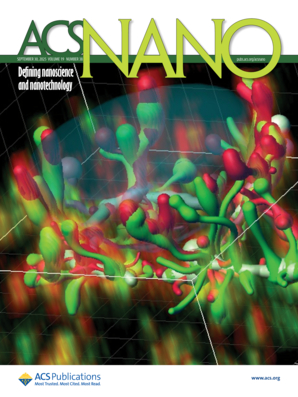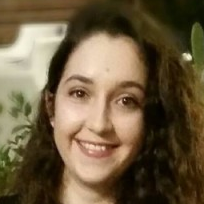-
17 Sep 2025 • Journal Article • ACS Nano
Circularly Polarized Luminescence from Assembled Nanoscale Particles
AbstractCircularly polarized luminescence (CPL) from assembled nanoscale materials presents a rapidly advancing field with significant implications for optoelectronics, bioimaging, and chiral photonics. The ability to engineer CPL-active systems through the controlled assembly of nanoscale particles offers a versatile platform for tuning chiroptical properties beyond what is
… show more
-
29 Aug 2025 • Journal Article • Journal of Photochemistry and Photobiology A: Chemistry
Photophysics of cu-loaded MIL-125(Ti)-NH₂: Unravelling the role of cu oxidation states through time-resolved spectroscopy and density functional theory
AbstractThe robust titanium-based metal–organic framework MIL-125(Ti)-NH₂ was loaded with Cu2+ ions (2 %, 5 %) as well as by nanoparticles of Cu0 (5 %). The ionic copper species were found to be atomically dispersed within the MOF pores, inducing a slight lattice expansion. In contrast, metallic copper was predominantly deposited at the MOF external surface, resulting in a more
… show more
-
14 Aug 2025 • Journal Article • Journal of Solid State Electrochemistry
Towards eco-friendly batteries: high temperature baking of carbonaceous (MCMB) Li-ion anodes containing advanced water-based natural polymer binders results in superior performance
AbstractReplacing common polymeric binder materials in lithium-ion batteries (LIBs) with more sustainable and environmentally friendly options is one of the challenges in designing new generations of LIBs. Here, we explain how incorporating protein-based polymers into the binder formulation can enhance binder performance in the graphite anode of LIBs. The electrode preparation
… show more -
8 Jul 2025 • Journal Article • Biophysical Journal
The role of ester- vs. ether-linked phospholipids in the ability of biological membranes to accept protons and support proton diffusion
AbstractIn biology, the distribution of ester-linked vs. ether-linked phospholipids is meaningful, such as in the abundance of ether-linked phospholipids in archaea vs. ester-linked phospholipids in bacteria/eukarya, and the presence of ether-linked phospholipids in some tissues of higher eukaryotes. Owing to biological membranes' capability of proton acceptance and supporting
… show more -
19 Mar 2025 • Journal Article • Chemical Science
The role of lipid phase and temperature in proton barrier and proton migration on biological membranes
AbstractBiological membranes play a major role in diffusing protons on their surfaces between transmembrane protein complexes. The retention of protons on the membrane's surface is commonly described by a membrane-associated proton barrier that determines the efficiency of protons escaping from surface to bulk, which correlates with the proton diffusion (PD) dimensionality at
… show more
-
3 Mar 2025 • Journal Article • ChemSusChem
Aqueous-based assembly of plant-derived proteins yields a crosslinker-free biodegradable bioplastic consistent with green chemistry principles
AbstractPlastics are an indispensable part of modern life. Due to the harmful environmental consequences of petroleum-based plastic usage, there is an urgent need to replace them with biodegradable bioplastics that meet the sustainability standards required for a low environmental footprint. Here, we use plant-derived proteins to produce bioplastics. Since most plant-derived
… show more
-
3 Mar 2025 • Preprint
A Molecular Donor-Acceptor System to Induce and Visualize Proton Transfer Across Biomolecules
AbstractProton transfer (PT) is at the heart of fundamental natural biochemical reactions, e.g. in bioenergetics, where proteins are the main proton mediators. PT between two specific points requires a change in the proton motive force via alteration of acid-base properties. Nature solved this problem primarily by modulating the protein structure during the PT process. Here
… show more -
4 Feb 2025 • Patent • Applied at: WO, US
Protein-based films
AbstractProtein based highly stretchable compositions with ionic conductivity are disclosed herein. Methods for preparing such compositions are also disclosed.
-
31 Jan 2025 • Journal Article • Angewandte Chemie
Photoacids and Photobases: Applications in Functional Dynamic Systems
AbstractBrønsted photoacids and photobases are a unique class of molecules that undergo a major change in their pKa values between their ground and excited states, resulting in donating or accepting a proton, respectively, but only after light excitation. This property of photoacids/photobases makes them an attractive tool for light-gating various dynamic processes. Here, we
… show more
-
7 Oct 2024 • Journal Article • Polymer Electrolyte Fuel Cells and Water Electrolyzers 24 (PEFC&WE 24)
Development of Sustainable, Environment-Friendly Protein-Based Proton Exchange Membranes for Fuel Cells and Water Electrolyzers
AbstractIn the twenty-first century, proton-exchange membrane fuel cells (PEMFCs) and water electrolyzers (PEMWEs) represent promising technologies for clean and efficient power generation. Proton exchange membranes (PEMs) are the key components in PEMFCs and PEMWEs. Currently, all proton exchange membranes (PEMs) employed in PEMFCs or PEMWEs are based on synthetic primarily
… show more -
1 Oct 2024 • Journal Article • Current Opinion in Electrochemistry
Long range electron transfer and proton transfer in biology: What do we know and how does it work?
AbstractElectron transfer (ET) and proton transfer (PT) events are involved in most of the biochemical processes in biology, such as within the aerobic respiration system and photosynthesis. Whereas most of the ET and PT reactions in biology are short-range on the (sub-)nanometer scale, several biological systems are capable of long-range ET or PT on the hundreds of nanometers
… show more -
2 Jul 2024 • Journal Article • Biophysical Journal
Proton diffusion on the surface of mixed lipid membranes highlights the role of membrane composition
AbstractProton circuits within biological membranes, the foundation of natural bioenergetic systems, are significantly influenced by the lipid compositions of different biological membranes. In this study, we investigate the influence of mixed lipid membrane composition on the proton transfer (PT) properties on the surface of the membrane. We track the excited-state PT (ESPT)
… show more -
30 May 2024 • Patent • Applied at: US
Proteinaceous electrode binder
AbstractThe present invention discloses a slurry for electrode preparation, relevant to the field of electrode fabrication for various applications, which consists of an active material, a conductive additive, and a binder composition that includes a proteinaceous substance that may comprise amino acids, peptides, and/or proteins. The instantly disclosed slurry is useful in
… show more -
23 Apr 2024 • Preprint • ChemRxiv
Fluorophore Concentration Controls the Homo-FRET Efficiency and Directionality across Proteins both in Solution and in Solid Protein Matrices
AbstractLight harvesting in nature is one of the most important processes, starting with the absorption of light by chromophores within proteins and the transfer of energy from one another via the Förster resonance energy transfer (FRET) mechanism. If the energy is transferred between identical chromophores, the resulting is Homo-FRET. Here, we introduce an artificial system
… show more -
13 Feb 2024 • Journal Article • ACS Nano
Solid-State Molecular Protonics Devices of Solid-Supported Biological Membranes Reveal the Mechanism of Long-Range Lateral Proton Transport
AbstractLateral proton transport (PT) on the surface of biological membranes is a fundamental biochemical process in the bioenergetics of living cells, but a lack of available experimental techniques has resulted in a limited understanding of its mechanism. Here, we present a molecular protonics experimental approach to investigate lateral PT across membranes by measuring
… show more
-
12 Feb 2024 • Journal Article • Chemistry – A European Journal
Controlling pH-Sensitive Chemical Reactions Pathways with Light - a Tale of Two Photobases: an Arrhenius and a Brønsted
AbstractLight-gated chemical reactions allow spatial and temporal control of chemical processes. Here, we suggest a new system for controlling pH-sensitive processes with light using two photobases of Arrhenius and Brønsted types. Only after light excitation do Arrhenius photobases undergo hydroxide ion dissociation, while Brønsted photobases capture a proton. However, none
… show more
-
8 Feb 2024 • Preprint • bioRxiv
The interplay between proton diffusion across biological membranes and their biophysical properties highlights the role of defects in mixed lipid membranes
AbstractProton circuits within biological membranes are at the heart of natural bioenergetic systems, whereas different biological membranes are characterized by different lipid compositions. In this study, we investigate how the composition of mixed lipid membranes influences the proton transfer (PT) properties of the membrane by following the excited-state PT (ESPT) process
… show more -
30 Jan 2024 • Journal Article • Nano Letters
Light-Triggered Reversible Change in the Electronic Structure of MoO3 Nanosheets via an Excited-State Proton Transfer Mechanism
AbstractLight is an attractive source of energy for regulating stimulus-responsive chemical systems. Here, we use light as a gating source to control the redox state, the localized surface plasmonic resonance (LSPR) peak, and the structure of molybdenum oxide (MoO3) nanosheets, which are important for various applications. However, the light excitation is not that of the MoO3
… show more
-
26 Dec 2023 • Journal Article • The Journal of Physical Chemistry Letters
Light-Triggered Enhancement of Fluorescence Efficiency in Organic Cages
AbstractThe fluorescence efficiency of excited molecules can be enhanced by many external factors. Here, we showcase a surprising phenomenon whereby light is used as a gating source to increase the fluorescence efficiency of organic cages composed of biphenyl subunits. We show that the enhancement of fluorescence is not due to structural changes or ground-state events
… show more
-
29 Nov 2023 • Preprint • ChemRxiv
Solid-state lateral proton conduction via solid-supported biological membranes reveals the role of membrane structure and bound water in proton transport
AbstractLateral proton transport (PT) on the surface of biological membranes is a fundamental biochemical process in the bioenergetics of living cells, but a lack of available experimental techniques has resulted in a limited understanding of its mechanism. Here, we introduce a new molecular protonics experimental approach to investigate lateral PT across membranes by measuring
… show more




























































